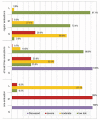The Role of Follow-up in Monitoring the Outcomes of Prematurity in a Cohort of Romanian Infants
- PMID: 28251019
- PMCID: PMC5322514
- DOI: 10.4274/balkanmedj.2015.1125
The Role of Follow-up in Monitoring the Outcomes of Prematurity in a Cohort of Romanian Infants
Abstract
Background: The rate of preterm births in Romania is one of the highest among European countries. However, there is little information regarding the ways in which premature birth affects the outcome in Romanian preterm infants.
Aims: To investigate the effects of early developmental intervention after discharge from the hospital on motor and cognitive development in preterm infants.
Study design: Longitudinal observational study.
Methods: We performed the Amiel-Tison neurologic evaluation at discharge and the Bayley Scales of Infant Development from 3 to 24 months. Based on these evaluations, an outcome score was formulated.
Results: Between 2007 and 2010, 1157 of 2793 premature infants were included into the study. There was a negative correlation between the number of evaluations and the risk of developing neurologic sequelae (p<0.001). The correlation analysis demonstrated a significant association between the final category of risk at the end of the follow up program and the degree of compliance (p<0.01). At 24 months evaluation, there was a correlation between the low gestational age and the risk of developing severe neurologic sequelae (p<0.001).
Conclusion: This study shows the importance of follow up program in decreasing the risk of developing neurologic sequelae in preterm infants.
Keywords: Neurologic sequelae; infants; monitoring; prematurity.
Conflict of interest statement
Conflict of Interest: No conflict of interest was declared by the authors.
Figures




Similar articles
-
Health, Physical Growth, and Neurodevelopmental Outcomes in Preterm Infants of Women With Hypertensive Disorders of Pregnancy.J Obstet Gynecol Neonatal Nurs. 2019 Jan;48(1):69-77. doi: 10.1016/j.jogn.2018.10.003. Epub 2018 Nov 29. J Obstet Gynecol Neonatal Nurs. 2019. PMID: 30502314 Free PMC article.
-
Individualized developmental care for the very low-birth-weight preterm infant. Medical and neurofunctional effects.JAMA. 1994 Sep 21;272(11):853-8. JAMA. 1994. PMID: 8078162 Clinical Trial.
-
Developmental care does not alter sleep and development of premature infants.Pediatrics. 1997 Dec;100(6):E9. doi: 10.1542/peds.100.6.e9. Pediatrics. 1997. PMID: 9382910 Clinical Trial.
-
Cue-based versus scheduled feeding for preterm infants transitioning from tube to oral feeding: the Cubs mixed-methods feasibility study.Health Technol Assess. 2021 Dec;25(74):1-146. doi: 10.3310/hta25740. Health Technol Assess. 2021. PMID: 34878383
-
Nutrition, growth, and allergic diseases among very preterm infants after hospital discharge.Dan Med J. 2013 Feb;60(2):B4588. Dan Med J. 2013. PMID: 23461996 Review.
Cited by
-
Case report: Tackling the complexities of an extremely premature newborn with intrauterine growth restriction and congenital metabolic disorders through a multidisciplinary approach.Front Pediatr. 2023 Jun 19;11:1162226. doi: 10.3389/fped.2023.1162226. eCollection 2023. Front Pediatr. 2023. PMID: 37404553 Free PMC article.
References
-
- Kerstjens JM, Bocca-Tjeertes IF, Winter AF, de, Reijneveld SA, Bos AF. Neonatal morbidities and developmental delay in moderately preterm-born children. Pediatrics. 2012;130:e265–72. - PubMed
-
- Stoll BJ, Hansen NI, Bell EF, Shankaran S, Laptook AR, Walsh MC, et al Eunice Kennedy Shriver National Institute of Child Health and Human Development Neonatal Research Network. Neonatal outcomes of extremely preterm infants from the NICHD Neonatal Research Network. Pediatrics. 2010;126:443–56. - PMC - PubMed
-
- Platt MJ, Cans C, Johnson A, Surman G, Topp M, Torrioli MG, et al. Trends in cerebral palsy among infants of very low birth weight (<1500 grams) or born prematurely (<32 wk) in 16 European centres. Lancet. 2007;369:43–50. - PubMed
Publication types
MeSH terms
LinkOut - more resources
Full Text Sources
Other Literature Sources
Medical
